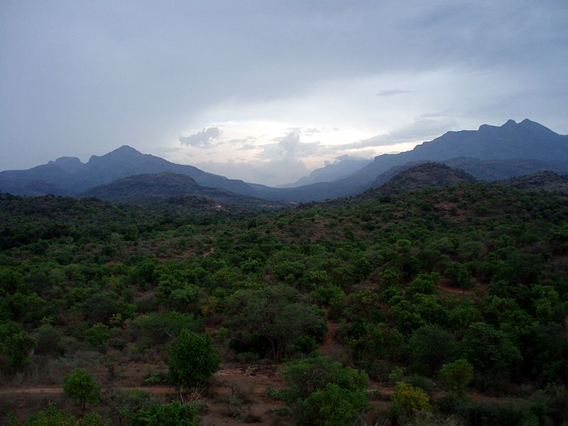
Anamalai Hills viewed from Chinnar Wildlife Sanctuary. Photo by: Matthieu Aubry.
Policymakers seeking to conserve forests in southern India should focus on those receiving the highest levels of rainfall, according to new research. Scientists from the Center for International Forestry Research (CIFOR) found rainfall to be the most important environmental determinant of species richness in the Anamalai region of the southern Western Ghats.
The Western Ghats comprise just six percent of the Indian landmass yet contain almost a third of all plant and vertebrate species found countrywide. This includes 1,500 endemic flowering plants. While regarded as one of the “Hottest Hotspots” of biodiversity in the Old World tropics, the Western Ghats teeter on the brink of ecological collapse. Between 1920 and 1990 forest cover declined by more than a third, resulting in more numerous and smaller forest patches. Scenarios generated by Intergovernmental Panel on Climate Change (IPCC) also predict that India could experience warmer temperatures and less predictable rainfall as a result of climate change, particularly if the summer monsoon becomes shorter and more intense. The wet, rich and biodiverse forests are exactly those most at risk from the effects of more prolonged drought and human pressures.
“While we cannot control rainfall itself, what we can do is conserve those landscapes that have high rainfall,” said Shijo Joseph from the Center for International Forestry Research, the lead author of the study. With forests vanishing, the recommendations from this research could be particularly timely as policymakers struggle to assign limited budgetary resources to maximize conservation returns.
“We need to know what key environmental drivers are acting on the region to help prioritize land for conservation,” added Joseph.
When researching the structure and composition of Anamalai forests, scientists found that rainfall was the primary factor influencing tropical forest diversity. An increase in annual rainfall from 400 millimeters (mm) in thorny scrub regions to 4,500 mm in rainforests resulted in a threefold increase in species richness.
Though this generalization is applicable to the Western Ghats, it may not hold true for all the Old World tropics. In tropical Asia, for example, high rainfall areas such as Mt. Cherrapunji, Assam, are characterized by relatively low plant species richness. And in tropical Africa, two high rainfall sites (over 5,000 mm/year) in southwestern Cameroon had only marginally more species than sites from northeastern Gabon that receive less than 2,000 mm of annual rainfall.
Still, in the context of climate change, focusing only on those areas that are currently rich in biodiversity could also be incredibly short-sighted. A study last year of European protected areas suggests that by 2080 climate perturbations could lead to new environmental conditions that are no longer be suitable for more than half of vertebrate and plant species in the parks.
“Here come the need to preserve contiguous land areas of varying environmental gradients to ensure species corridors are kept open to combat climate change,” Joseph said.
The findings from the present study may allow limited conservation resources to be channeled into areas with the richest set of species. The crucial role of rain cannot be understated, according to scientists.
Instead of trying to influence precipitation, we can instead try to follow what nature is providing,” Joseph concluded.
Related articles
Livelihoods depend on the environment in the Western Ghats
(09/27/2012) In the Uttar Kannada district of the Western Ghats, the livelihood of the average individual depends largely on the well being of the environment. Six months ago, before large-scale mangrove planting of the area, if someone were to walk through the banks of the mangroves in the Western Ghats he would see many fishermen casting their long nets and wires, time and time again noticing pieces of trash such as plastic grocery bags tangled in the nets.
Recommendations to save India’s Western Ghats creates political stir

(08/20/2012) A massive expert panel report on the conservation of the Western Ghats has caused a political stir in India. The report, headed by noted ecologist Madhav Gadgil, recommends that the government phase out mining projects, cancel damaging hydroelectric projects, and move toward organic agriculture in ecologically-sensitive sections of the Ghats. The report, which was leaked after the government refused to release it, has yet to be implemented. Recently dubbed a UNESCO World Heritage Site, the Western Ghats is one of India’s largest wildernesses and home to thousands of species, many found no-where else.
Poaching results in elephant gender imbalance in Indian park
(07/09/2012) Scientists have undertaken a new census of Asian elephants (Elephas maximus) in India’s Biligiri Rangaswamy Temple Tiger Reserve (BRT) following almost 30 years of sustained poaching. Estimating that the park contains four female elephants for every male, the scientists warn in a new study in mongabay.com’s open access journal Tropical Conservation Science that this gender imbalance threatens the population. Poachers target male Asian elephants for their tusks, generally leaving females untouched.
India’s Western Ghats rainforest declared UNESCO World Heritage Site
(07/03/2012) India’s Western Ghats, considered one of the richest biodiversity hotspots in the world, has been dubbed a UNESCO World Heritage Site. In total, 39 different sites in the tropical rainforest—home to Asian elephants, Bengal tigers, lion-tailed macaques, and thousands of other species—have made it under the listing.
Photos: 10 new frogs discovered in India’s great rainforest

(08/09/2011) Ten new species of frog have been discovered in India’s Western Ghats according to two new papers in Biosystematica. Although human populations have farmed in the Western Ghats for centuries, the new discoveries prove that the rainforest still holds many surprises. The Western Ghats lie along India’s west coast and have been dubbed one of the world’s biodiversity hotspots, but the rich wildlife is imperiled by rising human impacts.
Balancing agriculture and rainforest biodiversity in India’s Western Ghats

(08/08/2011) When one thinks of the world’s great rainforests the Amazon, Congo, and the tropical forests of Southeast Asia and Indonesia usually come to mind. Rarely does India—home to over a billion people—make an appearance. But along India’s west coast lies one of the world’s great tropical forests and biodiversity hotspots, the Western Ghats. However it’s not just the explosion of life one finds in the Western Ghats that make it notable, it’s also the forest’s long—and ongoing—relationship to humans, lots of humans. Unlike many of the world’s other great rainforests, the Western Ghats has long been a region of agriculture. This is one place in the world where elephants walk through tea fields and tigers migrate across betel nut plantations. While wildlife has survived alongside humans for centuries in the region, continuing development, population growth and intensification of agriculture are putting increased pressure on this always-precarious relationship. In a recent paper in Biological Conservation, four researchers examine how well agricultural landscapes support biodiversity conservation in one of India’s most species-rich landscapes.